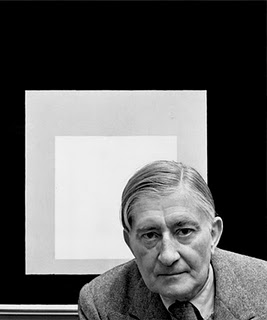<Back to Index>
- Artist and Educator Josef Albers, 1888
PAGE SPONSOR

Josef Albers (March 19, 1888 – March 25, 1976) was a German born American artist and educator whose work, both in Europe and in the United States, formed the basis of some of the most influential and far - reaching art education programs of the 20th century.
Albers was born in Bottrop, Westphalia, Germany. He studied art in Berlin, Essen and Munich, before enrolling as a student in the basic course of Johannes Itten at the prestigious Weimar Bauhaus in 1920. The director and founder of the Bauhaus, Walter Gropius, asked him in 1923 to teach in the preliminary course ‘Werklehre' of the Department of Design to introduce newcomers to the principles of handicrafts, because Albers came from that background and had appropriate practice and knowledge. In 1925, Albers was promoted to Professor, the year the Bauhaus moved to Dessau. At this time, he married Anni Albers (née Fleischmann) who was also a student there. His work in Dessau included designing furniture and working with glass. As a younger art teacher, he was teaching at the Bauhaus with artists including Oskar Schlemmer, Wassily Kandinsky and Paul Klee. Klee was the so-called form master who taught the formal aspects in the glass workshops where Albers was the crafts master; they cooperated for several years.
With the closure of the Bauhaus under Nazi pressure in 1933, Albers emigrated to the United States; in November 1933, he joined the faculty of Black Mountain College, North Carolina, where he ran the painting program until 1949. At Black Mountain, his students included Robert Rauschenberg, Cy Twombly, Ray Johnson and Susan Weil. He also invited important American artists as Willem de Kooning, to teach in the summer seminar. Weil remarked that, as a teacher, Albers was "his own academy" and said that Albers claimed that "when you’re in school, you’re not an artist, you’re a student", though he was very supportive of self expression when one became an artist and began his or her journey. Albers produced many woodcuts and leaf studies at this time.
In 1950, Albers left Black Mountain to head the Department of Design at Yale University in New Haven, Connecticut. While at Yale, Albers worked to expand the nascent graphic design program (then called "graphic arts"), hiring designers Alvin Eisenman, Herbert Matter and Alvin Lustig. Albers worked at Yale until he retired from teaching in 1958. In 1962, as a fellow at Yale, he received a grant from the Graham Foundation for an exhibit and lecture on his work. At Yale, Richard Anuszkiewicz and Eva Hesse were notable students. Albers also collaborated with Yale professor and architect King - lui Wu in
creating decorative designs for some of Wu's projects. Among these were
distinctive geometric fireplaces for the Rouse (1954) and DuPont (1959)
houses, the façade of Manuscript Society,
one of Yale's secret senior groups (1962), and a design for the Mt.
Bethel Baptist Church (1973). Also, at this time he worked on his
structural constellation pieces. In 1963, he published Interaction of Color which
presented his theory that colors were governed by an internal and
deceptive logic. Also during this time, he created the abstract album
covers of band leader Enoch Light's Command LP records. He was elected a Fellow of the American Academy of Arts and Sciences in 1973. Albers continued to paint and write, staying in New Haven with his wife, textile artist Anni Albers, until his death in 1976.
Accomplished as a designer, photographer, typographer, printmaker and poet, Albers is best remembered for his work as an abstract painter and theorist. He favored a very disciplined approach to composition. Most famous of all are the hundreds of paintings and prints that make up the series Homage to the Square. In this rigorous series, begun in 1949, Albers explored chromatic interactions with flat colored squares arranged concentrically. Painting usually on Masonite, he used a palette knife with oil colors and often recorded colors used on the back of his works.
In 1971 (nearly five years before his death), Albers founded the Josef and Anni Albers Foundation, a non - profit organization he hoped would further "the revelation and evocation of vision through art." Today, this organization not only serves as the office Estate of both Josef Albers and his wife Anni Albers, but also supports exhibitions and publications focused on Albers works. The official Foundation building is located in Bethany, Connecticut, and "includes a central research and archival storage center to accommodate the Foundation's art collections, library and archives, and offices, as well as residence studios for visiting artists." The U.S. copyright representative for the Josef and Anni Albers Foundation is the Artists Rights Society. The Josef and Anni Albers Foundation is represented by The Pace Gallery, New York.
Albers's work represents a transition between traditional European art and the new American art. It incorporated European influences from the constructivists and the Bauhaus movement, and its intensity and smallness of scale were typically European. But his influence fell heavily on American artists of the late 1950s and the 1960s. "Hard - edge" abstract painters drew on his use of patterns and intense colors, while Op artists and conceptual artists further explored his interest in perception.